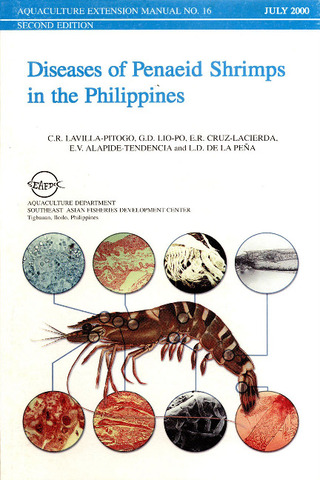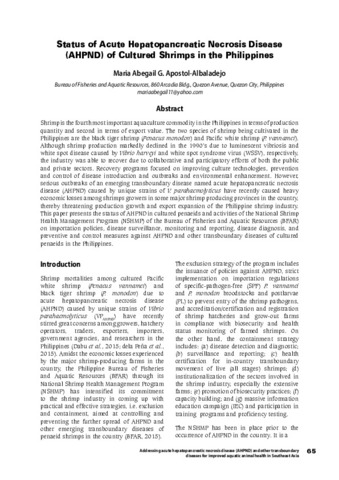Broodstock management and seed production of Penaeus monodon (Fabricius)
- Global styles
- MLA
- Vancouver
- Elsevier - Harvard
- APA
- Help

Date
1988Page views
12,896ASFA keyword
sexual behaviour 
shrimp culture
husbandry diseases
pond culture
disease control
survival
life cycle
induced ovulation
seed production
larval stage
environmental factors
eyestalk extirpation
rearing techniques
sexual maturity
reproductive cycle
cage culture
feeding experiments
reproductive behaviour
parasitic diseases
breeding stock
mortality causes
aquaculture techniques
crustacean larvae

shrimp culture

husbandry diseases

pond culture

disease control

survival

life cycle

induced ovulation

seed production

larval stage

environmental factors

eyestalk extirpation

rearing techniques

sexual maturity

reproductive cycle

cage culture

feeding experiments

reproductive behaviour

parasitic diseases

breeding stock

mortality causes

aquaculture techniques

crustacean larvae

AGROVOC keyword
Taxonomic term
Metadata
Perlihat publikasi penuh
Share
Abstract
Research on the maturation of Penaeus monodon at AQD has focused on three broad areas, namely, reproductive biology and ecology, induced maturation and broodstock management. Studies on reproductive biology provided information on the life cycle, ovarian maturation stages, courtship and mating behavior, minimum size at sexual maturation (sperm occurrence, first spawning), and morphological egg types. Induced maturation has mainly been done through the eyestalk ablation method. Nutritional and environmental parameters were studied to enhance reproductive performance or as an alternative to ablation. Pond-reared and wild broodstock sources and marine pen and land-based tanks as maturation systems were also tested and compared. Size, shape, color, substrate material and other aspects of tank design and construction, sex ratio, stocking density, water management, and other parameters of the management system were also studied and refined.
Early techniques in larval and postlarval rearing of P. monodon at AQD were based on the community culture method of growing natural food in larval tanks. However, low and inconsistent survival led to a shift in rearing methods toward pure phytoplankton culture grown in separate tanks as food for the larvae. Henceforth, refinement of rearing methods have been conducted to improve larval survival through effective water management, nutrition, and disease control. Efforts are continuously being geared toward making the technology affordable to Filipino farmers.
Suggested Citation
Parado-Estepa, F., & Honculada-Primavera, J. (1988). Broodstock management and seed production of Penaeus monodon (Fabricius). In J. V. Juario & L. V. Benitez (Eds.), Perspectives in Aquaculture Development in Southeast Asia and Japan: Contributions of the SEAFDEC Aquaculture Department. Proceedings of the Seminar on Aquaculture Development in Southeast Asia, 8-12 September 1987, Iloilo City, Philippines. (pp. 149-168). Tigbauan, Iloilo, Philippines: SEAFDEC, Aquaculture Department.
Type
Conference paperISBN
971851113XKoleksi
- ADSEA '87 [20]
Related items
Showing items related by title, author, creator and subject.
-
Series: Aquaculture extension manual; No. 16
Diseases of penaeid shrimps in the Philippines
Lavilla-Pitogo, Celia R.; Lio-Po, Gilda D.; Cruz-Lacierda, Erlinda R.; Tendencia, Eleonor ; de la Peña, Leobert D. (Aquaculture Department, Southeast Asian Fisheries Development Center, 2000)
The manual provides information on the diseases that affect the 3 major species of shrimps cultured in the Philippines: Penaeus monodon, P. merguiensis and P. indicus. It includes the common name of the disease, causative ...
; de la Peña, Leobert D. (Aquaculture Department, Southeast Asian Fisheries Development Center, 2000)
The manual provides information on the diseases that affect the 3 major species of shrimps cultured in the Philippines: Penaeus monodon, P. merguiensis and P. indicus. It includes the common name of the disease, causative ... -
Current status of shrimp farming and diseases in Cambodia
Lang, Ouch; Sothea, Mey (Aquaculture Department, Southeast Asian Fisheries Development Center, 2016)The farming of penaeid shrimps in Cambodia began in 1989 and has significantly expanded since 1991. Shrimp cultivation has been carried out in the four coastal provinces, i.e. Kampot, Kep, Preah Sihanouk Ville, and Koh ... -
Status of acute hepatopancreatic necrosis disease (AHPND) of cultured shrimps in the Philippines
Apostol-Albaladejo, Maria Abegail G. (Aquaculture Department, Southeast Asian Fisheries Development Center, 2016)Shrimp is the fourth most important aquaculture commodity in the Philippines in terms of production quantity and second in terms of export value. The two species of shrimp being cultivated in the Philippines are the black ...





